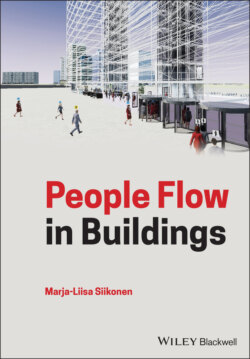Читать книгу People Flow in Buildings - Marja-Liisa Siikonen - Страница 32
2.10 Smart Sensing and Mobile Computing
ОглавлениеSensor‐enabled mobile devices have been widely used for various applications (Guihai et al. 2015 ). Real‐time people‐counting techniques through event tracking and mobile crowd‐sensing give business owners and operators a new channel to communicate with their customers. Internet and smartphone applications, enable a person's location to be followed anywhere in the globe almost in real time through navigation satellites. A mobile phone listens to the relative positions of different GPS satellites and is able determine its location on a map. The mobile location data is transferred to cloud servers via cell towers, or Wi‐Fi or Bluetooth connection (Figure 2.9). Cloud servers track and analyze the anonymous location data, and give back the gathered history and live data to mobile applications. One of the well‐known GPS applications is the car navigator, which shows the location of the car on the map and advanced applications suggest car routes without traffic jams. A user can see the suggested route on the map and follow his location on the map when he moves on the route (Google 2019 ). One can also follow another person's (mobile's) location on a map in real time with the other person's permission. Some applications also count the relative passenger numbers on defined map locations and track visit durations. Train applications can use, e.g. GPS‐based Automatic Vehicle Routing (AVR) with APC (Trimet 2019 ). They support travellers in planning their trips and can give on‐board passenger information and real‐time information of route‐related matters (Passengera 2019 ).
Figure 2.9 Modern user real‐time tracking service.
Inside buildings a user mobile application may not hear the GPS signals and it is not possible to use it in indoor wayfinding. Indoor Positioning Systems (IPS) that can locate people inside the buildings include sensors based on radio waves, magnetic fields, acoustic signals, or mobile phones. Transition from outdoor navigation to indoor navigation can be completely seamless. With an open Wi‐Fi or Bluetooth connection from a mobile phone to Internet, the user location can be determined, e.g. in airports or big city buildings. The indoor navigation platform is interfaced with the positioning system of the building, and it is possible to create building floor layouts with an IPS application. The user is then able to follow his own real time position on the floor map as shown in Figure 2.10, or to use location‐based services such as push messaging. Passenger crowding can be shown by heat maps. Needless to say that there are plenty of indoor navigation providers (mapspeople 2019 ; visioglobe 2019 ; proximi.io 2019 ). Wayfinding is one of the future applications that improves user experience when moving inside of different types of buildings. The challenge is the vertical positioning where elevators are essential in transporting passengers. To acquire comprehensive people flow on floors requires information of the building levels, which most probably will be solved by the future navigation systems.
Figure 2.10 Wayfinding by a mobile phone
(Source: proximi.io (2019 )).
